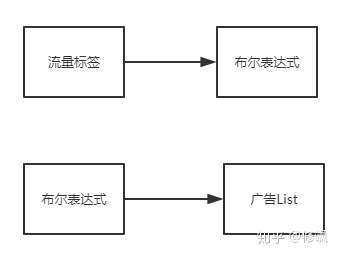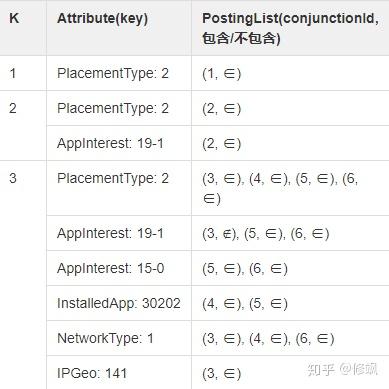问题背景
广告主在广告投放平台勾选定向条件之后,当用户发起一个请求之后,需要广告引擎快速筛选出符合定向条件的广告。我们当然可以想到如下的代码结构:
Attributes = list<Attribute> // 用户的流量标签,例如:用户的年龄、性别...
for (Ad ad : ads) {
check attributes for each ad. // 对于每一个广告检查是不是符合流量标签,挑选广告.
}
但是这样的问题是随着广告的数量增长而增长的,显然不能满足业务发展需要。无论是在品牌广告,还是竞价广告中,该问题都会遇到。很自然的,我们想到建索引,那么索引结构如何设计就成为问题的关键。
索引结构

两层索引结构
为了说明两层索引结构,我们定义如下术语:
- Attribute。单个流量标签,包含两个信息:属性类别和属性取值。如:
AGE: 5 - Assignment。多个流量标签组成的用户画像。如:
AGE: 5,GENDER: 1,NETWORK: 1 - Conjunction。布尔表达式的合取范式。如:
AGE ∈ (4,5,6) ∧ GENDER ∈ (1) - Predicate。布尔表达式的一个子表达式。如:
AGE ∈ (4,5,6),GENDER ∈ (1)
两层索引设计的主要思想是:从Assignment 找出包含这些流量标签的Conjunction,筛选满足条件的Conjunction,根据筛选出的Conjunction,找出满足条件的广告集合。下面我们举个例子:
假设线上有7个广告,它们定向条件如下,其中A3和Ad7定向条件相同。Ad6包含反向定向,即该广告不能出在AppInterest的标签为(19-1)的用户上面。
Ad1定向:PlacementType∈(2)
Ad2定向:PlacementType∈(2) ∧ AppInterest∈(15-0, 19-1) ∧ InstalledApp∈(30202)
Ad3定向:PlacementType∈(2) ∧ AppInterest∈(15-0, 19-1) ∧ NetworkType∈(1)
Ad4定向:PlacementType∈(2) ∧ AppInterest∈(19-1)
Ad5定向:PlacementType∈(2) ∧ InstalledApp∈(30202) ∧ NetworkType∈(1)
Ad6定向:PlacementType∈(2) ∧ IpGeo∈(141) ∧ NetworkType∈(1) ∧ AppInterest∉(19-1)
Ad7定向:PlacementType∈(2) ∧ AppInterest∈(15-0, 19-1) ∧ NetworkType∈(1)
对应定向条件有6个Conjuntion,可编号Conjuntion如下:
conjunctionId conjunction size
1 PlacementType∈(2) 1
2 PlacementType∈(2) ∧ AppInterest∈(19-1) 2
3 PlacementType∈(2) ∧ IpGeo∈(141) ∧ NetworkType∈(1) ∧ AppInterest∉(19-1) 3
4 PlacementType∈(2) ∧ InstalledApp∈(30202) ∧ NetworkType∈(1) 3
5 PlacementType∈(2) ∧ AppInterest∈(15-0, 19-1) ∧ InstalledApp∈(30202) 3
6 PlacementType∈(2) ∧ AppInterest∈(15-0, 19-1) ∧ NetworkType∈(1) 3
其中,conjunctionId为编号,conjunction为布尔表达式内容,size为∈语句的个数。
可以建立conjunctionId到Ad的索引如下:
conjunction1 -> Ad1
conjunction2 -> Ad4
conjunction3 -> Ad6
conjunction4 -> Ad5
conjunction5 -> Ad2
conjunction6 -> Ad3,Ad7
流量标签到布尔表达式的索引如下:

流量标签到布尔表达式索引
如上图,建立K-Index
- K 代表Conjuntion的size大小
- PostingList代表包含/不包含这个Attribute的Conjuntion
算法原理
我们还是按照上面的例子说明,最后给出核心算法的伪代码。现在来了一个用户画像Assignment:
PlacementType:2
AppInterest:19-1
NetworkType:1
由于有三个流量标签,那么我们满足条件的只可能是1-Index, 2-Index,3-Index。这就是为什么上面建索引的时候需要建立一个K-Index的索引,加上K-Index可以根据数目进行算法剪枝。同时每一个PostingList中的Conjuntion都已按照ConjuntionId升序排列。我们以检测3-Index为例。根据Assignment可以从索引里面取到如Conjuntions:
PlacementType: 2 (3, ∈), (4, ∈), (5, ∈), (6, ∈)
AppInterest: 19-1 (3, ∉), (5, ∈), (6, ∈)
NetworkType: 1 (3, ∈), (4, ∈), (6, ∈)
需要判断当前最小的ConjuntionId至少出现在3个PostingList中,且不能出现∉的关系。
每次check完成之后按照conjuntionId重排序(方便检测是不是至少出现在3个PostingList中)。
PlacementType: 2 (3, ∈), (4, ∈), (5, ∈), (6, ∈)
AppInterest: 19-1 (3, ∉), (5, ∈), (6, ∈)
NetworkType: 1 (3, ∈), (4, ∈), (6, ∈)
-------------------------------------------------------
MatchedConjuntion = [] (check Conjuntion3,发现出现了∉,故不满足)
PlacementType: 2 (4, ∈), (5, ∈), (6, ∈)
NetworkType: 1 (4, ∈), (6, ∈)
AppInterest: 19-1 (5, ∈), (6, ∈)
-------------------------------------------------------
MatchedConjuntion = [] (check Conjuntion4,发现出现只出现在两个中,故不满足)
PlacementType: 2 (5, ∈), (6, ∈)
AppInterest: 19-1 (5, ∈), (6, ∈)
NetworkType: 1 (6, ∈)
-------------------------------------------------------
MatchedConjuntion = [] (check Conjuntion5,发现出现只出现在两个中,故不满足)
PlacementType: 2 (6, ∈)
AppInterest: 19-1 (6, ∈)
NetworkType: 1 (6, ∈)
-------------------------------------------------------
MatchedConjuntion = [6] (check Conjuntion6,至少出现在三个中,且没有∉关系,满足)
按照该算法继续检测2-Index、1-Index。得到最终结果: MatchedConjuntion =[1,2,6]。再根据MatchedConjuntion 检索出广告 MatchedAds = [Ad1, Ad4, Ad3,Ad7]。
算法伪代码
c++版本可以参考《计算广告》 P225.
维度爆炸问题
有的同学觉得这里会出现维度爆炸的问题,比如有50个兴趣标签,5个年龄段标签,2个性格标签。最极端的情况是可能会出现:
50 * 5 * 2 * ... = 100 * ...
随着定向维度的增加而爆炸,实际上并不会,因为定向维度是取决于广告的规模的,最极端情况,假设我们线上有100w的广告,且这100w的广告定向标签都不一样,那么问题规模也是100w,并不会出现维度爆炸。另外,实际上,线上大量广告的定向标签是重复的,100w的广告定向的Conjuntion,远远小于广告数量。
用ES可以做吗?
这篇文章发出去之后,虽然点赞数寥寥无几,但是私信我的人蛮多。在这里提供另一种思路,如果你的公司是一个小公司,也没必要自己因为性能造轮子,直接使用es进行索引即可。es检索的dsl条件的伪代码如下:
[(不存在性别定向)|| (存在性别定向且满足条件)]
&& [(不存在年龄定向)|| (存在年龄定向且满足条件)]
&& [(不存在标签定向)|| (存在标签定向且满足条件)]
...
这样就可以把通投的(无任何定向)广告和有定向且满足条件的广告检索出来。
例如:请求是:26岁的男性用户,那么实际的es的dsl为:
{
"must": [
{
"bool": {
"should": [
{
"bool": {
"must_not": {
"exists": {
"field": "age"
}
}
}
},
{
"bool": {
"should": [
{
"range": {
"age.min": {
"from": null,
"to": 26,
"include_lower": true,
"include_upper": true
}
}
},
{
"range": {
"age.max": {
"from": 26,
"to": null,
"include_lower": true,
"include_upper": true
}
}
}
]
}
}
]
}
},
{
"bool": {
"should": [
{
"bool": {
"must_not": {
"exists": {
"field": "gender"
}
}
}
},
{
"term": {
"gender": "男"
}
}
]
}
}
]
}
